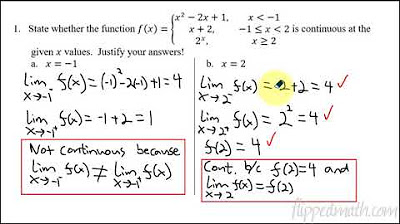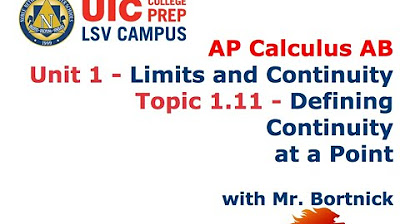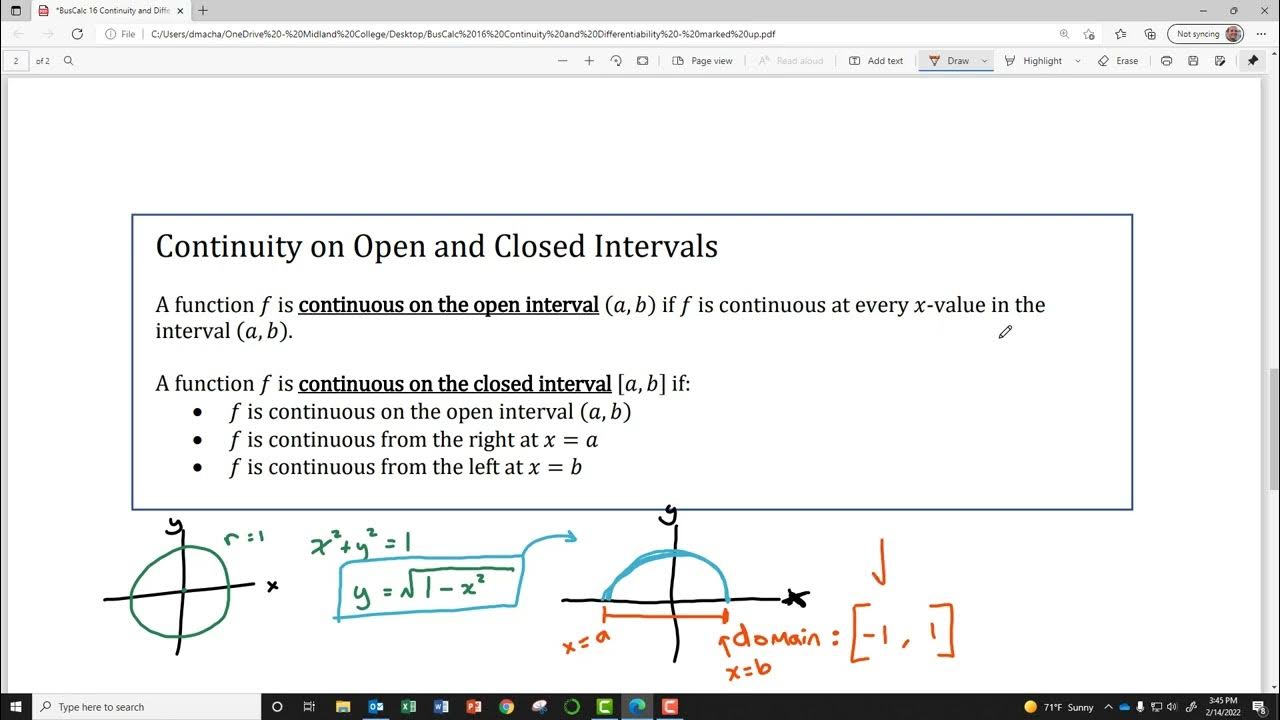Continuity
TLDRThis educational video script delves into the concept of continuity in calculus, explaining the three criteria a function must meet to be considered continuous at a point: the function value must exist, the limit must exist, and both must match. It illustrates this with examples of different types of discontinuities, such as point, jump, and asymptotic discontinuities, and demonstrates how some can be fixed by redefining the function. The script also covers piecewise functions and how to ensure continuity across breakpoints by equating the function expressions at the point of transition.
Takeaways
- 📚 The video discusses the concept of continuity in calculus, focusing on the conditions required for a function to be continuous at a single point x equals C.
- 🔍 A function is continuous at x equals C if three conditions are met: f(c) must be defined, the limit as X approaches C of f(X) must exist, and f(c) must equal the limit as X approaches C of f(X).
- 📈 The video illustrates the concept with examples, showing that a filled in circle at x equals C indicates f(c) is defined, which is the first condition for continuity.
- 🚫 The script explains that if f(c) is not defined (an open circle at x equals C), the function is not continuous at that point, demonstrating a violation of the first condition.
- 🔄 The video also covers the scenario where the limit as X approaches C does not exist, showing a jump discontinuity where the function approaches different values from the left and right.
- 💡 It is emphasized that for continuity, the function value at c (f(c)) and the limit as X approaches C must match, highlighting the third and crucial condition.
- 📉 The script introduces different types of discontinuities, such as point discontinuity (also known as removable discontinuity), jump discontinuity, and asymptotic discontinuity, explaining their characteristics and differences.
- 🔧 The video provides an example of how a removable discontinuity can be fixed by factoring, showing the transformation of a function with a removable discontinuity into a continuous one.
- 📊 The script discusses piecewise functions and their potential discontinuities, emphasizing the importance of matching the function values at the breakpoint to ensure continuity.
- 📚 The video concludes with a practical example of determining the continuity of a piecewise function by solving for a constant that makes the function continuous at the breakpoint.
Q & A
What is the main topic of this video?
-The main topic of this video is continuity in calculus, specifically discussing the conditions for a function to be continuous at a single point.
What are the three conditions that must be true for a function to be continuous at a point x=c?
-The three conditions are: 1) The function value f(c) must be defined. 2) The limit as x approaches c of f(x) must exist. 3) The function value f(c) must equal the limit as x approaches c of f(x).
What does it mean for f(c) to be defined in the context of continuity?
-For f(c) to be defined, there must be a filled in circle at the point x=c on the graph of the function, indicating that the function value exists at that point.
What is the significance of the limit as x approaches c of f(x) existing?
-The existence of the limit as x approaches c of f(x) means that the function approaches a specific value as x gets arbitrarily close to c, and this value must be the same from both the left and the right.
What is a jump discontinuity and how does it differ from other types of discontinuities?
-A jump discontinuity occurs when the graph of the function approaches different values from the left and the right as x approaches c. This results in a gap in the graph, which cannot be fixed by factoring.
What is an asymptotic discontinuity and what causes it?
-An asymptotic discontinuity occurs when the graph of the function approaches a vertical asymptote as x approaches c, often caused by dividing by zero. This type of discontinuity cannot be fixed by factoring.
What is a removable discontinuity and how can it be fixed?
-A removable discontinuity occurs when the function is not defined at x=c, but the limit as x approaches c exists. It can often be fixed by redefining the function at that point, such as by factoring out common terms.
How can you determine if a function is continuous at a point by looking at its graph?
-A function is continuous at a point if there are no gaps, holes, or undefined points in the graph at that point. The function value at that point must match the limit as x approaches the point from both sides.
What is the process for determining the values at which a function is discontinuous?
-To determine the values at which a function is discontinuous, you need to check for points where the function is not defined, where the limit as x approaches that point does not exist, or where the function value does not match the limit.
How does the video illustrate the concept of continuity using piecewise functions?
-The video uses piecewise functions to show how a function can be continuous by ensuring that the different pieces of the function match at the breakpoints, thus creating a continuous graph.
Outlines
📚 Understanding Continuity in Calculus
The script introduces the concept of continuity in calculus, emphasizing the three criteria that must be met for a function to be considered continuous at a point x=c. These include the function value f(c) being defined, the limit as x approaches c existing, and the function value matching the limit. The script also explains the importance of these criteria in creating a graph without gaps or holes, illustrating the concept with examples of functions that do not meet these criteria, such as an open circle at x=c indicating an undefined function value, a jump discontinuity where the left and right limits do not match, and a case where the function value and the limit are defined but do not equal each other.
🔍 Types of Discontinuities in Functions
This paragraph delves into the specifics of different types of discontinuities, such as point discontinuities which can sometimes be removable if the function is not defined at a certain point but the limit exists. Jump discontinuities are highlighted as a type that cannot be fixed, characterized by the left and right limits approaching different values, creating a visible gap. Asymptotic discontinuities are also discussed, which occur when the function approaches a vertical asymptote, typically due to division by zero, and are irreversible. The script provides examples of functions with these discontinuities and demonstrates how some can be remedied by factoring, while others cannot.
📈 Graphing and Analyzing Piecewise Functions
The final paragraph of the script addresses the complexities of graphing piecewise functions, which have breakpoints that change the behavior of the function. The script provides a step-by-step guide on how to graph such functions, using the example of a function that switches from x+2 to 2-x at the breakpoint x=1. It also discusses how to ensure the continuity of piecewise functions by matching the function values on either side of the breakpoint, as demonstrated with an example where the function is defined differently for x<2 and x>2, and the constant k is determined to make the function continuous at x=2.
Mindmap
Keywords
💡Continuity
💡Limit
💡Function
💡Graph
💡Point of Discontinuity
💡Jump Discontinuity
💡Asymptotic Discontinuity
💡Removable Discontinuity
💡Factoring
💡Piecewise Function
Highlights
Introduction to the concept of continuity in calculus.
Three conditions for a function to be continuous at a single point x equals C.
First condition: f(c) must be defined, meaning a filled in circle on the graph at x equals C.
Second condition: The limit as X approaches C of f(X) must exist.
Third condition: The function value at c (f(c)) must equal the limit as X approaches C of f(X).
Explanation of a continuous graph with no gaps or holes.
Examples of functions where f(c) is not defined, illustrating an open circle at x equals C.
Demonstration of a jump discontinuity where the limit from the left and right do not match.
Example where f(c) is defined and the limit exists, but they do not match, resulting in discontinuity.
Introduction to specific names for discontinuities: point, jump, and asymptotic.
Description of a point discontinuity, also known as a removable discontinuity, which can be fixed by redefining the function.
Explanation of a jump discontinuity, which cannot be fixed and is characterized by a gap in the graph.
Definition of an asymptotic discontinuity, which occurs when the function approaches a vertical asymptote.
Example of fixing a removable discontinuity by factoring in the function x squared minus X minus 6 over X minus 3.
Identification of an asymptotic discontinuity in the function 1 over X minus 3, which cannot be fixed.
Discussion on piecewise functions and their discontinuities, particularly at breakpoints.
Method to ensure continuity in piecewise functions by matching the function values at the breakpoint.
Transcripts
5.0 / 5 (0 votes)
Thanks for rating:





